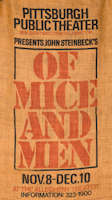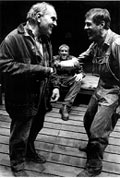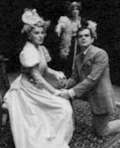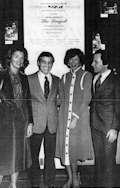
Fourth Season
September 27, 1978-May 6, 1979Season increased to eight and-a-half months including
Five Week “Season” at Chatham College
Five productions, five weeks each for the first time
13,350 Subscribers, $989, 000 Budget
Capacity increased to 350 seats
Begin Series of New Play Workshops
The Blood Knot
By Athol Fugard
Directed by Shaktman
Damien Leake returned after his great success in Medal of Honor Rag to play Zacharia. David Little made his first appearance here as Morris. Dialect coaching by Nora Dunfee; scenery by Bruce Miller and Shaktman; costumes by Laura Crow, lighting by Bennet Averyt and music by Misha Segal.
Of Mice and Men
By John Steinbeck
Directed by Shaktman
With David Little as George and Nicholas Wyman as Lenny; and David Clarke, Lanny Flaherty, Thomas L. Harbeck, Owen Hollander, Ellen Maxted; Scenery by John Jensen, costumes by Laura Crow, lighting by Bennet Averyt.
The Importance of Being Earnest
By Oscar Wilde
Directed by Shaktman
With Carol Teitel, Ivar Brogger, John Seidman, Carolyn Lagerfeld (?) and and; Designers: Costumes by David Toser; Lighting by Bennett Averyt?
Vanities by Jack Heifner &
Ashes by David Rudkin
Both directed by Terry Schreiber
The cast of Vanities was Elaine Bromka, Sally Dunn and Suzanne Toren. The cast of Ashes was Beth Dixon, Berkeley Harris, Gloria Maddox, and John C. Vennema. John Jensen, scenery, David Toser, costumes and Bennet Averyt, lighting.
At this point in our Fourth Season we had to depart from the Allegheny Theater/Carnegie Library facility by agreement with the city. In order to serve our rapidly growing subscriber base we made an arrangement with Dr. Alberta Arthurs, President of Chatham College in the Shadyside section of Pittsburgh to present our fifth production in the college’s theater, which held a few more than 350 seats. Our actors, designers and production staff conducted master classes and demonstrations as part of this arrangement.
At Chatham College
For Colored Girls Who Have Considered Suicide When the Rainbow is Enuf
By Ntozake Shange
Directed by Regge Life
Featuring Judyie Brandt, Celestine deSaussure, Gail Grate, Crystal Lilly, Carol E. Pennyfeather, Pamela Poitier, and Freda Scott. Scenery by Hal Tine', costumes by Toser, lighting by Averyt, choreography by John Parks.
Turning Point 1979
Popularity reflected by the rapidly increasing demand for subscriptions as well as increasingly favorable critical response to our work indicated that the part-time and temporary residency we were granted at the Allegheny Theater would choke our growth. In March as we were moving to Chatham College in order to present our fifth and last production of the season, the Mayor, Richard Caligiuri agreed to extend our forthcoming (Fifth) season’s use of the building to nine months. That same month the Saturday Review’s critic Henry Hewes wrote that with the Pittsburgh Public Theater “Shaktman proved that no town is a bad theater town. There is a right theater for every city.”
In April, the Post-Gazette editorial commented: “There is every reason to share the hope that this institution will become to theater here what the Pittsburgh Symphony is to music.” In August a market study claimed that PPT could attract 30,000 to 50,000 more attendees each season. No one believed the huge numbers. But just about everyone believed that our audience potential was just being scratched. PPT was becoming a popular cultural institution but our performing home base would soon become inadequate to realize future growth.
Finally, in November the Mayor made a bold and public commitment to PPT. He granted us year-round use of the city-owned building for three years. In return the Board of Directors would commit to taking all required steps in those three years to plan and raise funds to move into a much larger, new theater of its own in the center of downtown. (Our performing facility was located in the Northside section of Pittsburgh across the Allegheny River from downtown.) Mayor Caligiuri said: “Any permanent theater of sufficient size should be located Downtown.”




